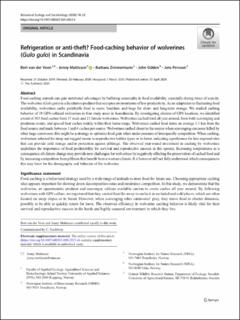Refrigeration or anti-theft? Food-caching behavior of Wolverines (Gulo gulo) in Scandinavia
Peer reviewed, Journal article
Published version
Permanent lenke
https://hdl.handle.net/11250/2677642Utgivelsesdato
2020Metadata
Vis full innførselSamlinger
Originalversjon
10.1007/s00265-020-2823-4Sammendrag
Food-caching animals can gain nutritional advantages by buffering seasonality in food availability, especially during times of scarcity. The wolverine (Gulo gulo) is a facultative predator that occupies environments of low productivity. As an adaptation to fluctuating Food availability, wolverines cache perishable food in snow, boulders, and bogs for short- and long-term storage. We studied caching behavior of 38 GPS-collared wolverines in four study areas in Scandinavia. By investigating clusters of GPS locations, we identified a total of 303 food caches from 17 male and 21 female wolverines.Wolverines cached food all year around, from both scavenging and predation events, and spaced their caches widely within their home range.Wolverines cached food items on average 1.1 km from the food source andmade between 1 and 6 caches per source.Wolverines cached closer to the source when scavenging carcasses killed by other large carnivores; this might be a strategy to optimize food gain when under pressure of interspecific competition.When caching, wolverines selected for steep and rugged terrain in unproductive habitat types or in forest, indicating a preference for less-exposed sites that can provide cold storage and/or protection against pilferage. The observed year-round investment in caching by Wolverines underlines the importance of food predictability for survival and reproductive success in this species. Increasing temperatures as a consequence of climate change may provide newchallenges for wolverines by negatively affecting the preservation of cached food and by increasing competition from pilferers that benefit from awarmer climate. It is however still not fully understood which consequences this may have for the demography and behavior of the wolverine.

